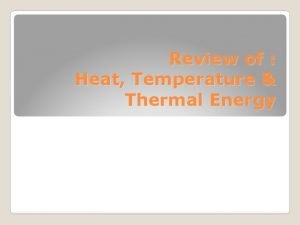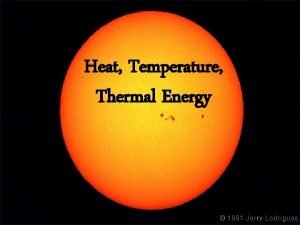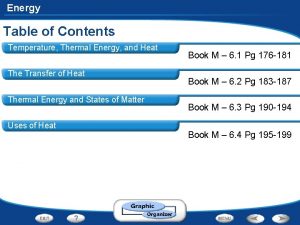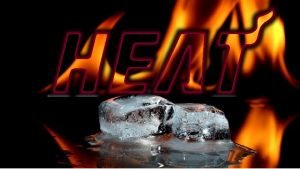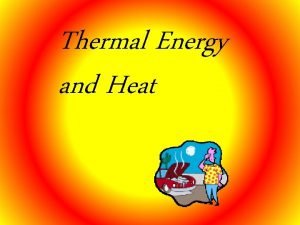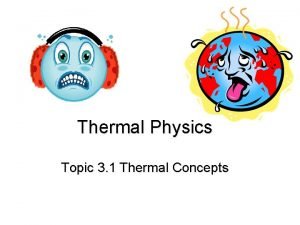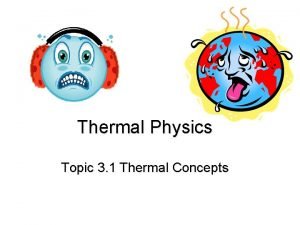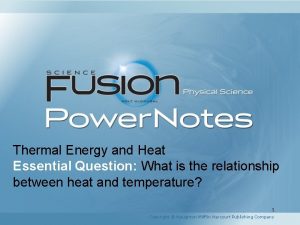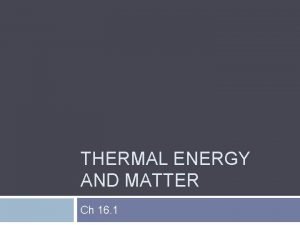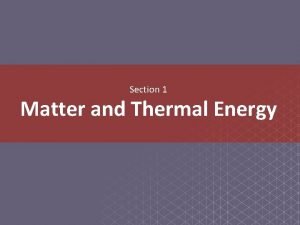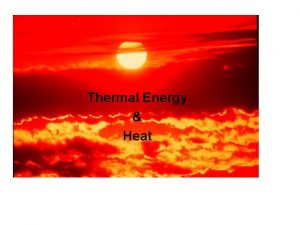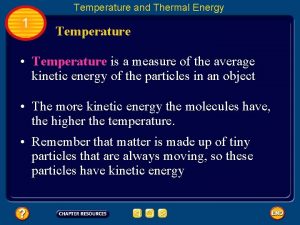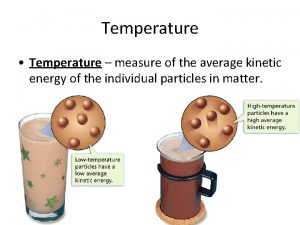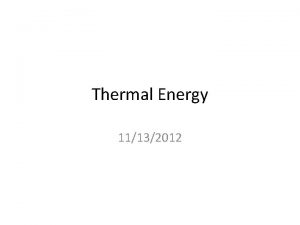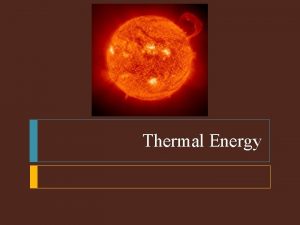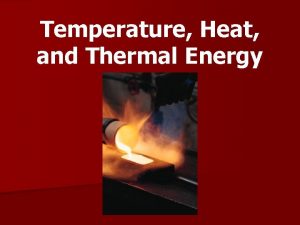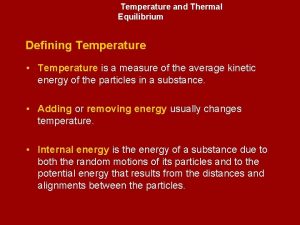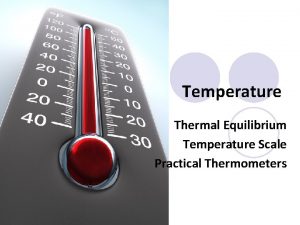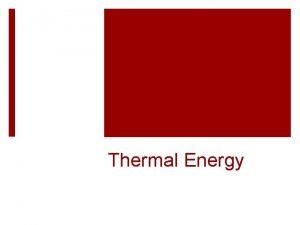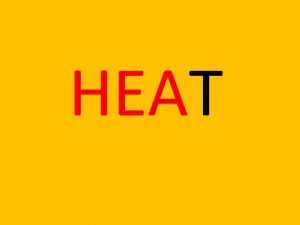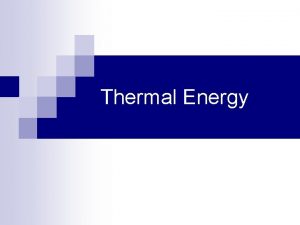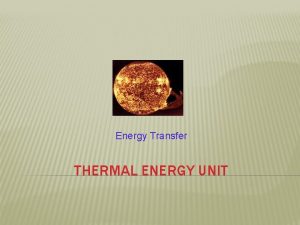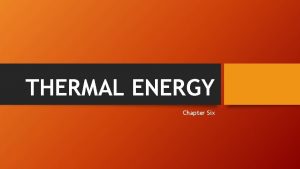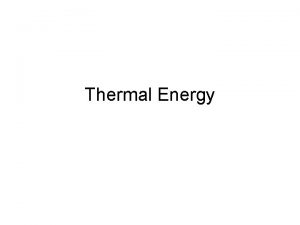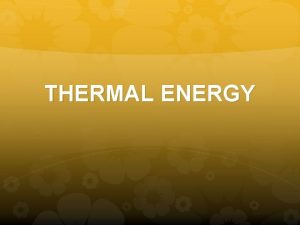Temperature and Thermal Energy 1 Temperature and energy






















- Slides: 22

Temperature and Thermal Energy 1 Temperature and energy Glencoe: Chapter 9 – Section 1: pages 254 -259

Temperature and Thermal Energy 1 Kinetic Theory of Matter • The motion of the particles in matter is described by kinetic theory of matter. • Matter is composed of particles that are atoms, molecules, or ions that always are in random motion.

Temperature and Thermal Energy 1 Temperature • The temperature of a substance is a measure of the average kinetic energy of its particles. • The SI unit for temperature is the Kelvin (K). • As kinetic energy increases the temperature increases

Temperature and Thermal Energy 1 • Here is a picture showing the three temperature scales side by side

Temperature and Thermal Energy 1 Temperature • B. Thermometer – device that measures temperature Relies on expansion of heated materials and contraction of cooled materials

Temperature and Thermal Energy 1 Temperature 1. Liquid thermometers – glass tube filled with a liquid Limited temperature range a. Mercury filled b. Alcohol filled Particles move faster as heated and expand rise up the tube

Temperature and Thermal Energy 1 Temperature 2. Metal thermometers 2 bonded strips of metal (2 different metals) that expand contract at different rates A coiled piece of metal

Temperature and Thermal Energy 1 Temperature • Commonly used temperature scales are the Celsius (o. C) scale, the Fahrenheit (o. F) scale, and the Kelvin (K) scale.

Temperature and Thermal Energy 1 Temperature Energy Transfer (heat and temperature) - A sense of touch is very important for determining temperature - If the temperature of an object is lower than skin temperature = cold material (ice) Energy is transferred from the warmer material (skin) to the cooler material as the object’s particles collide with the skin particles

Temperature and Thermal Energy 1 Temperature • If the temperature of an object is higher than skin temperature = warm material (hot water bottle) Energy is transferred from the warmer material to the cooler material (skin) as the object’s particles collide with the skin particles

Temperature and Thermal Energy 1 Thermal Energy • The sum of the kinetic and potential energies of all the particles in an object is thermal energy of the object. • The increase in an object’s speed doesn’t affect the random motion of its particles, so it doesn’t affect its thermal energy.

Temperature and Thermal Energy 1 Heat • Heat is thermal energy that flows from something at a higher temperature to something at a lower temperature. • Heat is a form of energy, so it is measured in joules. • The flow of energy always flows from higher energy (hot) to lower energy ** Warmer will try to “heat up” the cooler**

Transferring Thermal Energy 3 Ways to Transfer Thermal Energy Conduction • Energy transfers from one object to another • This transfer of energy as heat (thermal energy) as particles collide or objects collide is called conduction. • Kinetic energy is transferred when these faster-moving atoms collide with slowermoving particles.

Transferring Thermal Energy 3 Convection • Convection is the transfer of thermal energy in a fluid by the movement of fluid from place to place. • Transfer of energy by the movement of fluids with different temperatures. • A fluid expands as its temperature increases. • The density of the fluid therefore decreases.

Transferring Thermal Energy 3 Convection Current • Flow of a fluid due to heating and cooling • Warm fluids rise because they expand become less dense (lighter), then cool. • The warm water transfers thermal energy to the cooler water around it.

Transferring Thermal Energy 3 Convection • As the warm fluids cool, they contract and get heavier (denser) and sink. • As fluids sink they are warmed up again by the heat source. • The rising and sinking water forms a convection current.



Transferring Thermal Energy 3 Radiation • Radiation is the transfer of energy by electromagnetic waves. • Radiation can pass through solids, liquids, and gases, but the transfer of energy by radiation is most important in gases. • Examples: light, ultraviolet light, infrared light, sunlight, microwaves, x-rays • Does not involve the movement of matter.

Transferring Thermal Energy 3 Radiation • When radiation strikes a material, some energy is absorbed, some is reflected, and some may be transmitted through the material.

Transferring Thermal Energy 3 Conductors and Insulators 1. Conductor – material through which energy transfers easily - Examples – metals (energy transfers between particles easily) solids (not all solids) tend to be better conductors gases tend to be poor conductors

Conductors and Insulators 2. Insulator – material that poorly transfers energy - Examples – wood, plastic, rubberized materials, air, water
 Chapter 5 thermal energy answer key
Chapter 5 thermal energy answer key What is heat energy?
What is heat energy? Heat thermal energy and temperature
Heat thermal energy and temperature Temperature and heat
Temperature and heat Thermal energy vs heat energy
Thermal energy vs heat energy Heat vs thermal energy vs temperature
Heat vs thermal energy vs temperature Thermal energy vs temperature
Thermal energy vs temperature Thermal energy vs. temperature
Thermal energy vs. temperature Thermal energy vs temperature
Thermal energy vs temperature Thermal transfer vs direct thermal printing
Thermal transfer vs direct thermal printing Kinetic energy to thermal energy
Kinetic energy to thermal energy Thermal cycler temperature verification system
Thermal cycler temperature verification system Difference between curie temperature and neel temperature
Difference between curie temperature and neel temperature Difference between curie temperature and neel temperature
Difference between curie temperature and neel temperature Ferrimagnetism
Ferrimagnetism Difference between heat and thermal energy
Difference between heat and thermal energy Specific heat capacity of lead j/kg c
Specific heat capacity of lead j/kg c Difference between heat and thermal energy
Difference between heat and thermal energy Difference between heat and thermal energy
Difference between heat and thermal energy Thermal energy and mass
Thermal energy and mass Section 16.1 thermal energy and matter
Section 16.1 thermal energy and matter Matter and thermal energy section 1
Matter and thermal energy section 1 Lesson 1 thermal energy and the behavior of matter
Lesson 1 thermal energy and the behavior of matter


